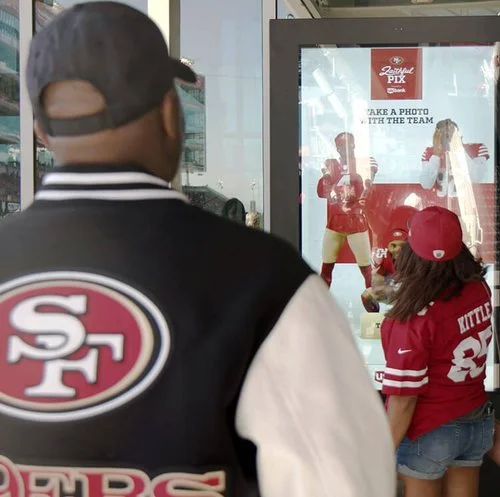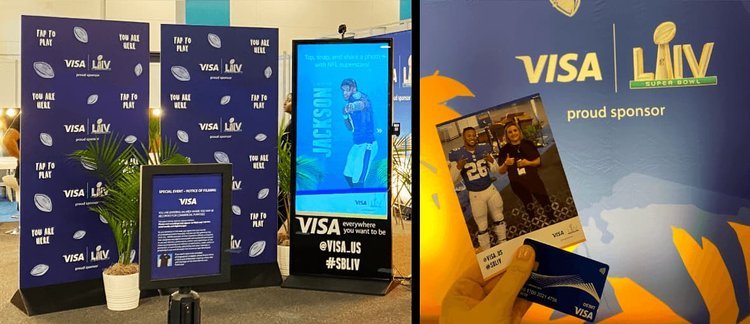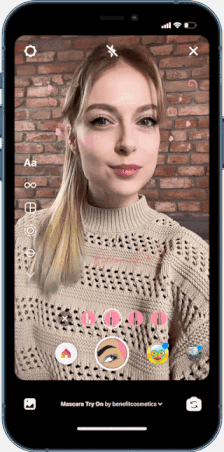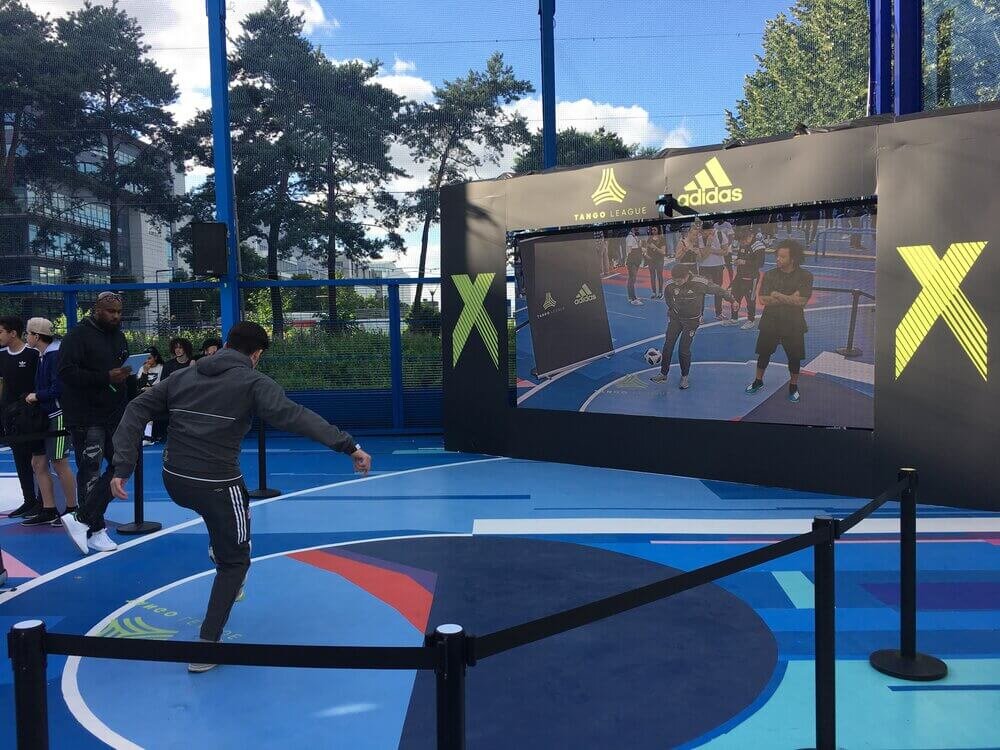8 Amazing Ways You Can Use Augmented Reality for Marketing
Augmented reality (AR) marketing is a strategy that creates an interactive experience combining the real and virtual world, enhancing how customers interact with products or services. With the sharp turn toward e-commerce in the post-pandemic world, this innovative technology has quickly become a must-have digital tool for companies.
AR technology transforms marketing efforts across numerous industries, enhancing customer experience, driving brand loyalty, and increasing revenue.
This article will explore why you should use AR to optimize your marketing strategy and the best ways to go about it.
AR Stopped Being a Nice-to-Have
Before diving into the ins and outs of AR in marketing, let’s go back to the basics. What is augmented reality?
As the name suggests, augmented reality is a technology that augments or enhances our perception of the surrounding physical world. Besides combining real-life elements with virtual reality, this cutting-edge technology takes place in real time and is often interactive.
Augmented reality marketing has proven highly effective in the digital age, eliciting a stronger emotional response than traditional marketing efforts. Augmented reality advertising allows customers to interact with a brand on a more personal level, thus boosting the brand’s perceived value and customer loyalty.
Numerous sectors have already successfully leveraged AR to take their marketing efforts to the next level, including beauty, fashion, tourism, and, above all, retail.
These and other sectors typically employ one or more of the four main types of AR:
Marker-based augmented reality. Marker-based AR requires a pre-defined trigger, such as a QR code, a barcode, or a watermark, to display virtual content.
Marker-less augmented reality. Nowadays, marker-less augmented reality is the most widely used image recognition method for AR applications, requiring no markers or triggers. Instead, the virtual object can be placed anywhere in the real world.
Superimposition-based augmented reality. More complex than other AR types, this technology aims to replace the original object with a generated view entirely or partially.
Screen-based augmented reality. In the context of LED screens and kiosks, screen-based augmented reality involves the use of large-scale displays to overlay virtual elements onto real-world environments. These interactive screens can provide immersive experiences for users in public spaces, events, or retail locations. By incorporating augmented reality content, LED screens and kiosks can engage audiences with interactive visuals, enhancing the overall user experience and creating unique opportunities for marketing, revenue generation and entertainment.
What Are the Benefits of Using Augmented Reality for Marketing?
Although employing augmented reality for marketing is no easy task, many companies choose to do so because of the numerous benefits this technology offers.
AR Boosts Brand Awareness
Boosting brand awareness is essential for a company’s marketing efforts because it helps establish a recognizable and memorable brand identity that builds a connection with customers. While highly beneficial, only a few companies have made AR a part of their marketing strategies. So, when you do it, and do it successfully, you’ll generate buzz and conversation about your brand among your target audience and beyond.
AR Improves the Customer and User Experience
Thanks to AR, your customers, and users can get all the information they need in an aesthetically-pleasing and interactive way. This promptness and playfulness significantly enhance their overall experience and perception of your company.
AR Educates Your Customers
Before AR, many customers may have hesitated to shop online, especially for products and services they’d never used. AR has managed to reduce purchase anxiety by providing easy access to all the necessary information and tools to make an informed decision.
AR Increases Conversion Rates
While it’s great to have as many eyes on your marketing projects as possible, the ultimate goal of most marketing strategies is to convert those visitors into customers. AR has almost created a level playing field between in-store and online shopping experiences, allowing companies to convert online leads into customers successfully. Of course, this eventually leads to a significant boost in sales.
AR Offers Increased User Engagement
With an endless stream of AR apps and tools, people will keep coming back and engaging with your content. True, some will do it just for fun. But even they will learn more about your products and services in the process, thus potentially becoming a customer.
AR Helps Build Customer Loyalty
AR marketing campaigns primarily focus on eliciting powerful emotions and gifting memorable experiences. As such, they’re more likely to create a positive association with your brand, which will, in time, turn into loyalty.
AR Reaches Younger Customers
Snapchat and Pokémon GO were the first to take AR technology mainstream. And what do these two platforms have in common? That’s right, a primarily younger audience. AR technologies will help you reach younger customers who are often quite passionate about the brands they support and can significantly influence your public perception.
AR Helps You Go Viral
In the modern digital age, social media platforms offer unparalleled opportunities to create fun and engaging content that can capture people’s attention and go viral virtually overnight. Combine the social media playing field with the ingenuity of AR marketing, and you get a winning recipe for online stardom.
AR Gives You a Competitive Advantage
People love novelties and exciting applications with which they can interact in today’s fast-paced digital age. AR gives you a chance to continuously produce creative content that will set you apart from the competition.
AR Helps Reduce Marketing Costs
One of the most common misconceptions about AR marketing is that it costs a fortune. However, AR-based ads are often more affordable than traditional media. At the same time, the cost of AR tools stays steady as technology advances.
The Most Common Uses of AR Marketing
The technology has permeated virtually every corner of the world. So, it’s not surprising that notable AR advertising examples can be found across numerous industries. Take a look at the eight fantastic uses of augmented reality for marketing below to get a little inspiration for your business.
Make a Splash With a New Product
Marketing efforts can make or break a new product launch. AR can help you introduce your product to the market with a bang. Make a virtual product for your audience to try out, create tie-in filters and lenses, or create a game that showcases its features in a fun and exciting way; the possibilities are virtually endless.
Warner Bros. celebrated the release of the live-action/animated film, “Pokémon: Detective Pikachu,” with a unique HeroMirror AR photo booth experience that created a photo-realistic picture with fans and their favorite Pokémon and movie leading cartoon – Pikachu. With an easy touchscreen interface, the AR experience guides the user through a simple, two-to-three-step process for a photo with the animated character.
Create an Unforgettable In-Store Experience
Generally speaking, people frequent physical stores less often than before, courtesy of a global pandemic. AR can help create an immersive in-store experience that will make those people want to visit your store and stick around. Think along the lines of scanning QR codes to unlock virtual product demonstrations, interactive storytelling, and more.
INDE was tasked with translating "The Magical Cookbook" experience into a modern in-store customer engagement in multiple Kroger and Fred Meyer stores across Portland, Columbus, and Atlanta. HeroMirror was the perfect fit for Kroger’s brief, so INDE created a series of Augmented Reality experiences that allow holiday shoppers to meet and interact with their favorite Krojis onsite and share their unique experiences on social media.
Let Customers Try It Before They Buy It
The COVID-19 pandemic has transformed the way people shop. For example, most customers aren’t as comfortable trying makeup products and clothing in-store as before. AR offers customers the possibility to do so without actually touching any makeup or clothes.
An example of AR in action was when INDE, a leading AR agency, collaborated with the makeup brand Benefit Cosmetics to allow makeup enthusiasts to try its new products without stepping foot in a store.
Take Touring to a New Level
With AR guidebooks, you can transform the same old tours into an interactive wonder like no other. Scanning these guidebooks provides additional visual and auditory information to make the tour one for the books.
Make Your Brand Voice Heard Loud and Clear
Your brand voice is a valuable asset that directly dictates how people perceive your business. With AR, you can make your brand voice heard loud and clear, from messages on your social media channels to elaborate virtual store windows.
INDE created an AR HeroMirror fan experience that promotes Visa’s, the giant financial service company’s new tap-and-pay tech during Super Bowl LIV. HeroMirror provided the opportunity for fans to meet, interact with and create unique moments with their heroes - some of the biggest stars of the NFL season.
INDE developed a custom AR experience for Pizza Hut featuring Pittsburgh Steelers wide receivers Antonio Brown and JuJu Smith-Schuster at Super Bowl LIII, providing NFL fans with the opportunity to participate in a “dance-off” with the superstar duo at Super Bowl LIII.
Turn Your Customers Into Experts
With the right AR marketing campaign, your customers can learn the ins and outs of your new products and services without feeling overwhelmed or bored.
For instance, INDE created an unforgettable immersive exploration of wildlife to help promote Coca-Cola’s conservation efforts. The Arctic Home Campaign by Coca-Cola and the World Wildlife Fund aimed at the protection of polar bears and their natural habitat, included an augmented reality event at the Science Museum in London.
Bid Boring Catalogs and Product Descriptions Farewell
AR can dramatically enhance product presentations in brick-and-mortar stores with eye-catching 3D models and detailed animations. AR can also bring branding materials to life, create funky packaging, and animate product catalogues.
Delight Your Customers With Exceptional Service
Investing in stellar customer support has been shown to increase revenue. Of course, AR can help you with that too. This technology can significantly improve your customer support efforts with remote assistance through video calls and 3D visualizations.
Augmented Reality and Marketing: A Match Made in Digital Heaven
AR marketing is much more than a fleeting trend. It looks to become one of the most promising strategies for businesses worldwide. Introducing AR marketing early on will allow your business to stand out among competitors, attracting new and dazzling current clients.
Of course, it’s crucial to find a reliable partner that will complement you, just like AR complements marketing. INDE has the knowledge, skills, and experience to craft the most imaginative AR solutions to put your business on the map.













